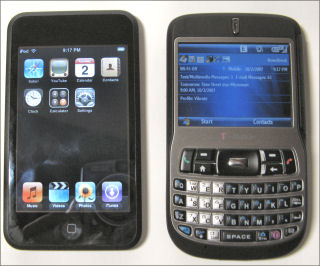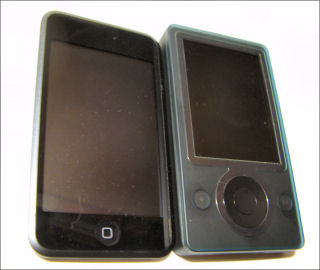
My 16GB iPod touch arrived yesterday. Since I’m probably among the last of the mobile enthusiasts who got a touch (even though I pre-ordered it the day it was announced), I’m not even going try to write a mini-review. However, as a Windows Mobile enthusiast, I thought other Windows Mobile users might find a couple of quick observations from that point of view interesting.
The T-Mobile Dash (Windows Mobile 6 Standard Edition, formerly Smartphone) has been my main device for the past half-year or so. As you can see from the photo the iPod touch and the Dash are pretty close in height and width dimensions although the touch is much thinner than the Dash (0.31 vs. 0.5 inches). According the to iPod touch spec page and the T-Mobile Dash spec page, both are 4.2 ounces. Frankly, I’m having a hard time believing this. The touch feels much much heavier than the Dash. But, I don’t have a scale to check this, so I’ll believe the specs. You can see that the screen is about twice the physical size of the Dash’s screen and is exactly twice the resolution (480×320 vs. 320×240).
The one thing that became obvious real fast is that thumb typing as I know it is impossible for me on the touch. The lack of tactile feedback and what appears to be a slight digitizing offset (selection appears slightly to the left of where I touch the screen) is deadly. My typing mode (especially for passwords) is reduced from two thumbs to my right hand index finger. I’m really tempted to use a stylus when I need to type on the touch. The Dash’s keyboard, on the other hand, is the best thumb keyboard I’ve used on a Smartphone (the Universal’s and TyTn’s keyboard are my favorites on the Pocket PC side of the Windows Mobile house).
One somewhat surprising aspect of the touch’s lack of tactile feedback is that I don’t think I can use it without looking at the screen. I’ve also used the iPod nano and the 5th generation iPod (video). Both of those are very easy to use without looking at the device because the click wheel gives lots of location and tactile information.
IMHO Apple was wise in NOT positioning the iPod touch as a PDA. It is clearly not a PDA. On the other hand, its Safari browser is clearly superior to Windows Mobile’s Internet Explorer (and Opera mini on Windows Mobile — for me anyway). That combined with a relatively easy (but not great) YouTube app makes the iPod touch the current overall multimedia champ. I just looked at the new Zune announcements. I think the Zune still has a lot of catching up to do. But, more on that after the firmware upgrade for the current generation Zune’s become available next month. I’ll flash my Zune then and give it a spin.


